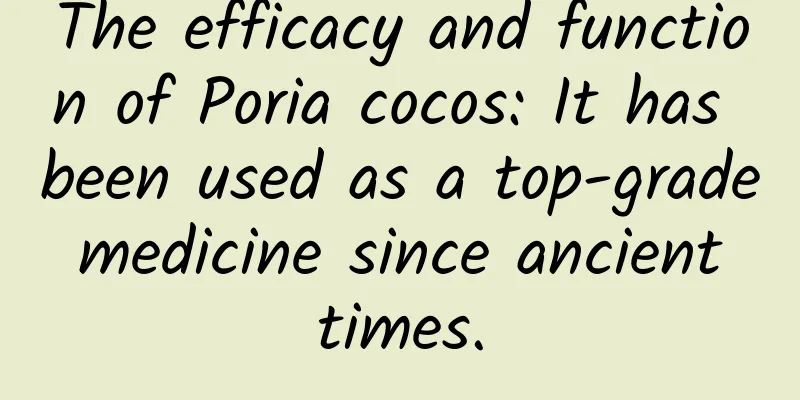The efficacy and function of Poria cocos: It has been used as a top-grade medicine since ancient times.

|
"Pharmaceutical Chemistry" states that white Poria cocos "has a unique sweet and mild taste. Sweetness can nourish, and mildness can penetrate. Sweet and mild taste belongs to the earth element, and can nourish the spleen yin, and the prosperous earth element can produce metal, and can also benefit the lung qi." It specifically proposes special pharmacological rules for white Poria cocos. When it comes to Poria cocos, people must be familiar with it. Whenever the rainy plum rain season comes, there will always be a Poria cocos cake or Poria cocos biscuit that becomes an indispensable food like a traditional custom. People will also add Poria cocos to soups to help the body promote diuresis and expel moisture. As a common food and medicine ingredient originating in my country, Poria cocos has a very long history and is known as the "miracle medicine of all seasons". Lu You also wrote "Pine root Poria cocos is extremely delicious" to praise the deliciousness and preciousness of Poria cocos. In recent years, it has been integrated into the international market, which means that the effects of Poria cocos are not fabricated, but have been tested by experience and time, and have been widely recognized in modern pharmacokinetics. So, what results have been achieved in the research of ancient Chinese doctors on Poria cocos, and how has modern science and technology identified the active ingredients of Poria cocos? 1. Active ingredients of Poria cocos Poria cocos is a traditional Chinese medicine, and the medicinal part is the dried sclerotium of the Polyporaceae fungus, that is, the inner part after the outer skin is removed. Modern researchers have mostly extracted the main components of Poria cocos from the sclerotium, but other parts such as Poria cocos skin also have certain nutritional value. According to known experimental results, the chemical composition of the traditional Chinese medicine Poria cocos is very complex and has a very large research space. So far, the chemical components discovered by medical researchers from Poria cocos mainly include polysaccharides, triterpenes, sterols, amino acids, fatty acids, etc., among which the biologically active compounds that have been confirmed are mainly concentrated in triterpenes and polysaccharides. At present, a total of 84 triterpenoid components and more than 60 polysaccharide components have been isolated and identified from the extracts of Poria cocos peel and sclerotium. Among them, triterpenoid compounds can be subdivided into eight types of triterpenoids, including tetracyclic other triterpenoids and pentacyclic triterpenoids, according to the differences in the number of atoms and spatial structure. The number is very large. In addition, two different diterpenoid compounds have been found in the peel and sclerotium of Poria cocos. Sterol compounds are also an important component of the organic components of Poria cocos, and this type of compound is mainly concentrated in the Poria cocos sclerotia and the Poria cocos mycelium that appears during reproduction, totaling seven types; in addition, the water-soluble polysaccharides and alkali-soluble polysaccharides of Poria cocos account for a very large proportion, which can reach more than 80%, and the content of the former is much lower than the latter. In addition, as a food ingredient that can be used as both medicine and food, Poria cocos contains considerable amounts of its three major energy-supplying nutrients. The calorie content of dried Poria cocos per unit mass (per 100 grams) can reach 178 kcal, including 1.2 grams of protein, which means that the amino acids hydrolyzed from it can also be studied as the effective ingredients of Poria cocos. The fat content of Poria cocos is very low, accounting for only 0.5%, which is a common characteristic of all fungi. The edible value of Poria cocos is mainly completed by carbohydrates, and the crude fiber content of 82.6 grams of carbohydrates accounts for 95%! It can be called the leader in high fiber; the vitamin content of dried Poria cocos is relatively low, only a weak vitamin B2 and a very small amount of niacin were detected; mineral components are also one of the substances that play a medicinal effect of Poria cocos, among which potassium, phosphorus, manganese, iron, magnesium, calcium and selenium are distributed, and trace amounts of zinc and copper are also identified in precise experimental methods and sophisticated experimental instruments. 2. The efficacy and role of Poria cocos and its suitable population The origin of the consumption of Poria cocos is long lost, and its history of being used as medicine can be traced back to the oldest medical book, Shennong's Classic of Materia Medica. Shennong listed Poria cocos as a top-grade medicine according to its medicinal efficacy, and made a preliminary judgment on its nature and flavor. It wrote, "Poria cocos is sweet in taste and neutral in nature. It is also called Futu. It grows in the valleys of Mount Tai." In the Ming Dynasty, Li Shizhen, an important founder of traditional medicine, said in his Compendium of Materia Medica that Poria cocos "has a light and penetrating smell, its nature is upward, it produces body fluids, opens the pores, nourishes the water source and descends, floats and rises, and this is its nature". In Bencao Qiuzhen, Poria cocos has been used as an important medicine for diuresis and dampness removal, and has the compatibility rules in classic prescriptions: when it is added to the Four Gentlemen, it is assisted by Ginseng and Atractylodes to penetrate the dampness of the spleen, and when it is added to the Six Flavors, it is used to make Alisma orientalis to remove kidney evil, which is the most important medicine for diuresis and dampness removal. The book says that it strengthens the spleen, which means that the spleen will be strengthened when the water is removed. Experience and research have enriched the medicinal value of Poria cocos in medical books of successive dynasties, and its efficacy has also changed from being single to being more complex. As people's understanding of Poria cocos becomes more in-depth, in the process of medical practice, slight differences in the efficacy and properties of different varieties of Poria cocos have been discovered, and the overall records of Poria cocos' medicinal effects have become more systematic and detailed. The "Pharmaceutical Chemical Meaning" states that white Poria cocos "has a unique sweet and mild taste. Sweetness can nourish, and mildness can penetrate. Sweetness and mildness belong to the earth, and can nourish the spleen yin, and the earth is strong to produce gold, and it can also benefit the lung qi." It specifically proposed the special pharmacological rules of white Poria cocos; the final "Chinese Pharmacopoeia" collected the research results of predecessors and made a very detailed summary: Poria cocos is sweet, mild, and neutral. It enters the heart, lung, spleen, and kidney meridians. Poria cocos is diuretic and dehumidifying, and it can strengthen the spleen and calm the heart. It is used for edema and oliguria, phlegm and fluid, dizziness and palpitations, spleen deficiency and poor appetite, loose stools and diarrhea, restlessness, palpitations and insomnia. There are some "lace" rumors about the effects of Poria cocos. The famous doctor Chu Shaosun of the Han Dynasty once said that Poria cocos can make people "immortal after eating it". In addition, the processed Poria cocos powder is as white as flour, so Poria cocos is known as the "immortal face" that prolongs life. There is also an allusion in the "Qiang Pu Zi" by Ge Hong, a Taoist in the Jin Dynasty where metaphysics was popular: Wang Ziji took Poria cocos for 18 years, and the Jade Maiden followed him. He could hide and show himself, did not eat spiritual grains, had a mass on his face, and had a jade bell. Tao Hongjing, a famous doctor in the Northern and Southern Dynasties, also said that Poria cocos "benefits the orifices and benefits the muscles, thickens the intestines and makes the heart happy, regulates the camp and regulates the defense, and is a top-grade immortal medicine." Through clinical trials on the active ingredients of Poria cocos, researchers have also partially confirmed the effects mentioned in ancient medical books, and have made new discoveries. Existing literature has certified that Poria cocos extract has biological activities such as anti-tumor, immunomodulatory, anti-inflammatory, antioxidant, anti-aging, memory improvement, urinary system regulation, blood sugar and lipid lowering, sedative and hypnotic, and liver protection. 1. Improve immunity and anti-tumor: The triterpenes and polysaccharides in Poria cocos can reduce the immune response of the experimental body to anti-tumor drugs by inhibiting enzyme activity, blocking the cell cycle, and activating the emergency apoptosis pathway of cancer factors such as gastric cancer cells, colon cancer cells, breast cancer cells, lung cancer cells, and liver cancer cells, thereby inducing cell apoptosis, and it also shows a good reversal effect on the anti-tumor drugs that increase the accumulation and retention in cells and the body's drug resistance. 2. Lowering blood sugar and blood lipids: Experiments have shown that the compounds isolated from Poria cocos sclerotium have the function of synergistically exhibiting significant insulin-like activity. They can replace insulin to stimulate the liver's glucose uptake efficiency, form liver glycogen for storage, reduce the stimulation of the body's insulin levels, and induce triglyceride accumulation and inhibit fat decomposition in differentiated adipocytes. They have the potential to treat metabolic syndrome or diabetes. 3. Sedation and hypnosis: Traditional medicine has described the efficacy of Poria cocos in calming the mind and treating restlessness, palpitations and insomnia, and the results of modern pharmacokinetic research are highly consistent with it. The complex of Poria cocos extract can significantly enhance the hypnotic effect of pentobarbital, reduce the potential difference of nerve cells, and make the nerve conduction rate tend to be moderate. The total triterpenes of Poria cocos have a significant anti-epileptic effect, which has a great pioneering significance in the current research of sedatives in my country. 4. Anti-oxidation and anti-aging: The active oxygen produced by the normal metabolism of the human body can induce peroxidation of cell membrane lipids, and Poria triterpenoids can remove peroxidation products while accelerating the autophagy of aging cells, thereby playing a good role in anti-oxidation, anti-aging, and maintaining the youthful vitality of the body. References: 【1】《A Brief History of the Medicinal Use of Poria Cocos》——Zhou Jingjing. A Brief History of the Medicinal Use of Poria Cocos[D]. Heilongjiang University of Traditional Chinese Medicine, 2015. 【2】“Knowledge and Use of Poria from Han to Tang”—Sun Yikong, 2017, 20(01): 60-64. 【3】Research Progress on Chemical Components and Biological Activities of Poria cocos, Xu Shuo, Jiang Wenqing, et al., 2016, 31(03): 327-330. 【4】 Wang Changbo, Huang Yuanying. Research progress on chemical components, biological activities and extraction methods of Poria cocos. 2014, 16(07): 1655-1663. 【5】Zhang Nian, Li Zhaoxing et al., “Research Progress on Chemical Composition and Biological Activities of Poria cocos”, 2019, 21(02): 220-233. |
>>: What are the benefits and effects of bitter melon? Do you need to peel the bitter melon?
Recommend
Low flow brown discharge from placenta
Low placenta poses certain risks to pregnant wome...
Is it normal to want to have sex during menstruation?
During the menstrual period, the uterus of women ...
Sensor Tower: SHEIN ranked second in the global shopping app download rankings in the first half of 2021
The 2002 pandemic caused a surge in online shoppi...
What to do if adolescent girls have acne on their faces
When middle school students enter puberty, on the...
What are the symptoms of non-gonococcal vaginitis?
There are many kinds of female vaginal diseases, ...
Headache during menstruation
Headaches during menstruation are a normal physio...
Causes of brown discharge during pregnancy
It is always very frightening when female friends...
Which is more cost-effective, paying in full or taking out a loan for a car worth 200,000 yuan? Why is the insurance and handling fee more expensive when taking out a loan?
Buying a car is also a big event in life. For a 2...
Music therapy for children with autism
Music therapy refers to a method of treating dise...
Normal progesterone value and balance method during menstruation
Nowadays, there are more and more female diseases...
What is the nutritional value of grapefruit? Can pregnant women eat grapefruit?
Grapefruit contains valuable natural vitamin P, r...
Causes and treatments of thick calves
The condition of thickening calves has a great im...
Is it normal for a woman to stop menstruating at 47?
As every woman ages, she will gradually enter men...
A woman dreams of an eagle
It is almost impossible to see wild animals and p...
What should you pay attention to when you have chronic pelvic inflammatory disease?
In our daily life, many women often suffer from a...









